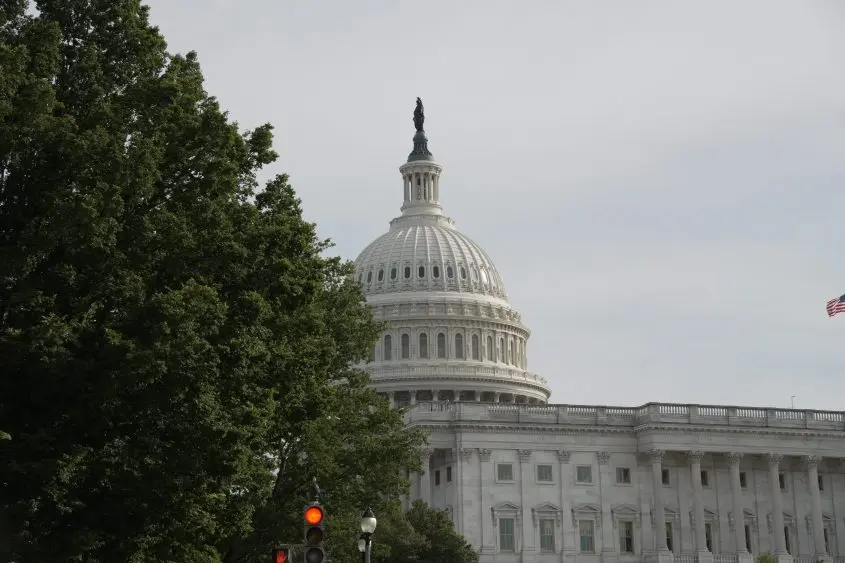
By:Paul Hammel Nebraska Examiner
LINCOLN — Advocates for rural Nebraska and telecommunications companies are expressing disappointment and some condemnation over the decision to propose spending only $43.8 million of the $405 million in federal money awarded to the state to expand high-speed internet “for all.”
These “provisional” awards by the Nebraska Broadband Office that Gov. Jim Pillen created raise the prospect that $350 million in unspent funds awarded to the state under the Broadband Equity Access and Deployment (BEAD) Act could be returned to Washington, D.C., and not spent here.
It also means, some advocates said, that up to 10,000 locations in rural Nebraska will settle for less-reliable satellite or wireless internet service instead of the top-of-the-line broadband delivered via fiber optic cables.
“If there were a trophy for squandering opportunity, Nebraska would already have it on the shelf,” said Emily Haxby, a Gage County Board member who has been a leader in seeking better internet service in her county and elsewhere.
“The outcome wasn’t what we hoped would be the best for the state,” said John Nelson, CEO of Hamilton Telecommunications, which has provided fiber optic internet for four decades. “I’m concerned that there are a lot of locations that will be left behind.”
Seward County Commissioner Misty Ahmic noted that Nebraska ranked last among 39 states by granting BEAD funds for fiber in only 9% of the eligible locations across the state. That’s far lower than states like Iowa and Kansas, which handed out more than 50% and 46%, respectively, toward more desirable fiber.
“Here, instead of fighting, state leaders just rolled over and called it good enough,” Ahmic said. “It feels like they just don’t care.”
Pillen, who created the State Broadband Office, did not respond to a request for comment from the Examiner.
But Patrick Haggerty, who heads the Nebraska Broadband Office, which produced the provisional awards, disputed the criticism in response to the Examiner’s emailed questions. He pointed to a need to comply with federal changes to the BEAD program.
The rules for awarding BEAD funds were “drastically modified” in June by the Trump administration, Haggerty said, putting a priority on the “lowest-cost” technology and removing the program’s preference for fiber-delivered internet.
“We continue to fight for the best outcome for Nebraska,” he said. “We have always known we would have to deploy a mix of technologies to reach every last location while being responsible stewards of taxpayer dollars.”
Haggerty added: “In the end, our goal did not change, and every Nebraska Broadband Serviceable location will be connected.”
The $42.45 billion BEAD program, approved by Congress in 2021, was touted by the Biden administration as bringing high-speed internet “to all,” though it’s also been criticized for its slow rollout and excess regulatory requirements, including the use of union labor.
About 30,000 locations across Nebraska were initially identified as eligible for BEAD-backed internet projects — areas deemed unserved or underserved by adequate broadband. High-speed internet is essential in allowing work-at-home jobs, guiding high-tech “precision agriculture” systems and permitting easier and faster downloads of movies, video games and college and high school coursework.
But the National Telecommunications and Information Administration (NTIA) announced several changes in the BEAD program designed to reduce spending after the election of Donald Trump as president a second time.
The main change was to end the priority for the extension of higher-cost fiber lines into rural areas and increased focus on the lowest cost technologies, such as fixed wireless from communication cellular towers and signals from satellites, such as those deployed by billionaires Elon Musk and Jeff Bezos.
In addition, about 7,500 locations in Nebraska once identified as eligible for BEAD grants were deemed ineligible after the NTIA criteria changed.
Nebraska’s provisional awards — which must be approved by the NTIA — were announced this month and include $2.3 million to Bezos’ Project Kuiper system, which is not yet providing service, and $2.5 million to Musk’s Starlink satellite internet system, which is already deployed.
The head of the Nebraska Telecommunications Association, which represents several small and mid-sized companies that deploy fiber internet service, called the awards “disappointing” due to the rule changes that were to the detriment of fiber, which he described as the best technology.

“Does this really bring broadband to unserved and underserved rural areas that’s equal to what you get in urban areas? It doesn’t,” said Tip O’Neill, the president of the NTA.
One organization, the Southeast Nebraska Development District, wrote the Nebraska Broadband Office in its official comment on the awards, saying that the funding decisions fail to solve “the digital divide” between rural and urban areas.
“Business owners, farmers, students, patients, and all Nebraskans benefit when they are connected,” the letter stated. “The Nebraska Broadband Office’s final proposal offers only marginal improvements in this regard, relegating well over 12,000 homes and businesses to second-class technologies.”
The letter also pointed out that Nebraska proposed fiber internet for only 9% of all locations, the lowest percentage of any state in the country — far less than similar rural states.
During a town hall to discuss the awards, a consultant reportedly said that Nebraska’s sometimes flat and treeless landscape likely contributed to wireless internet and satellite services proving the least costly options because of fewer hills and less foliage to block such internet signals.
Haggerty, the state broadband office chief, said he could not say why the broadband awards in neighboring Iowa and Kansas were so different but said, “Nebraska’s approach was rooted in careful analysis and compliance with NTIA’s requirements.”
“We also lacked fiber applications for the areas prioritized for fiber — NBO only received fiber applications for 14 out of 106 areas most conducive to fiber,” he added.
O’Neill, of the state telecommunications association, said that due to changes in the BEAD program fiber companies would have had to spend thousands to re-engineer company proposals that likely had little chance of approval.
Some advocates said Nebraska took far too conservative an approach toward the broadband awards, giving money to wireless and satellite companies when it should have pursued fiber.
Others maintain that Nebraska’s approach might prove wise given that the federal government could drastically amend the fiber awards in other states to save money.
In Nebraska, for instance, about 4,600 locations are proposed to be served by satellite internet, for about $1,000 per location or $4.7 million. By comparison, it would cost about $14,600 per location to service similar locations via fiber because of the cost of burying lines to remote locations. For fixed wireless, the cost is about $2,200 per location.
Because Nebraska had excess funds, it was able to propose awarding money for broadband at 54 so-called “community anchor institutions,” such as fire halls, hospitals and nursing homes. But advocates said the 54 were short of how many such institutions could have been served.
Overall, Haxby and other rural broadband advocates maintain that Nebraska fumbled an opportunity to help economic development and Nebraska farms and businesses. Fiber, she wrote, is a “lasting” technology that can be upgraded as internet speeds get faster.
“Fiber is the gold standard,” Haxby wrote in a commentary in the Examiner. “And we deserve leaders with the backbone to deliver it. Anything less is a betrayal of every family, farmer, business and student left behind on the wrong side of the digital divide.”



